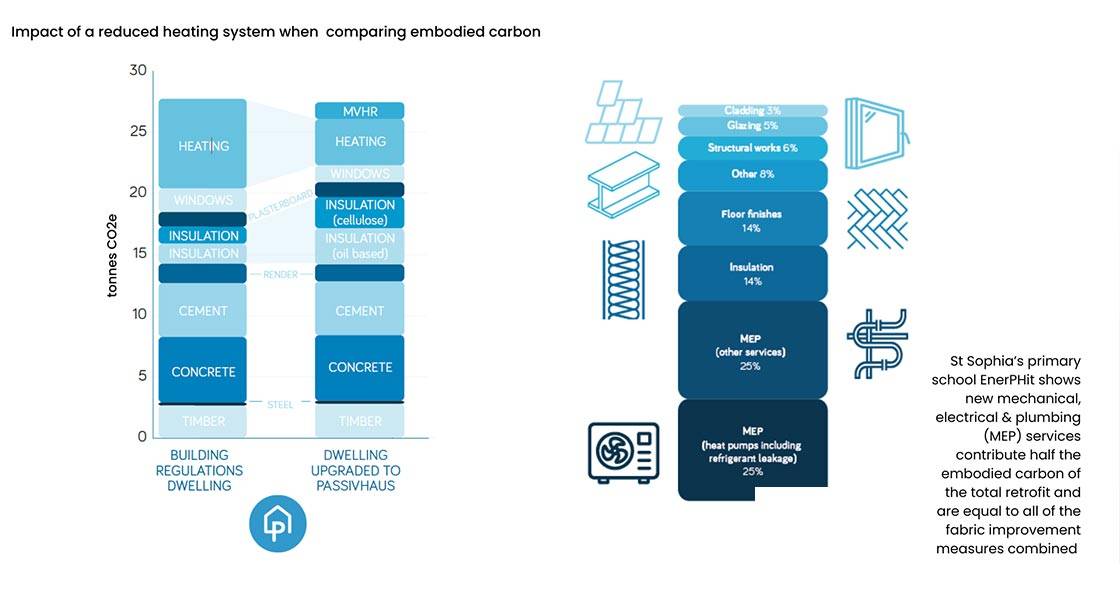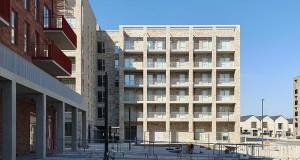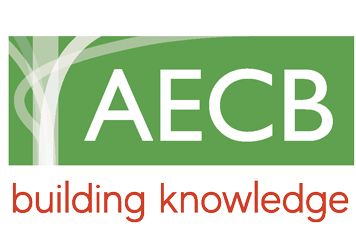
- General
- Posted
New passive house & embodied carbon resources
Do thicker insulated walls, triple glazed windows, & MVHR ventilation systems tip the scales unfavourably for passive house when it comes to embodied carbon?
This article was originally published in issue 42 of Passive House Plus magazine. Want immediate access to all back issues and exclusive extra content? Click here to subscribe for as little as €10, or click here to receive the next issue free of charge
The paper outlines the relationship between passive house and embodied carbon, addressing common misconceptions. It says: “Passivhaus buildings are optimised for net zero, providing the best route to minimise whole life carbon. Outstanding levels of building performance minimise operational carbon, while the passivhaus design methodology encourages optimisation of embodied carbon through efficient use of materials and radically reducing the heat and cooling plant.”
Comparing a house built to UK building regulations with the passive house standard, measured over 60 years, modelling shows that, even with additional building elements, the passive house has a lower initial embodied carbon and less operational carbon over its lifetime, leading to a smaller whole life carbon footprint.
By championing compact and rationalised design, improving the form factor of buildings and simplifying details, passive house buildings result in less material use, the modelling concluded. Building to the passive house standard also avoids the need for a later retrofit to meet more demanding standards.
Passive house quality assurance and use of higher quality materials contribute towards reducing embodied carbon through improved resource efficiency. Quality passive house components can offer longer product lifespans and a reduced need for repair and maintenance.
There are also substantial savings made in retrofitting existing buildings, compared with the high embodied energy costs of demolition and rebuilding. As an example, St. Sophia’s Primary School in East Ayrshire revealed that 40 per cent embodied carbon savings were made just by undertaking an Enerphit retrofit rather than rebuilding the school.
The passive house community is increasingly acknowledging and focusing on the issue of embodied carbon and material choices, demonstrated by the development of several carbon counting tools. The AECB PHribbon plug-in for PHPP makes whole life carbon calculations quick to perform using the material quantities already embedded in a PHPP assessment.
According to Passivhaus Trust policy and research director Sarah Lewis: “The relationship between embodied and operational carbon is rapidly changing. As buildings become more energy-efficient and heating is electrified, embodied carbon is a significantly larger slice of a smaller whole life carbon pie.”
Lewis added that efforts to tackle embodied carbon must not come at the expense of energy efficiency. “Continuing to reduce energy demand is still important as it reduces peak loads and shrinking our collective winter energy demand will reduce the level of future zero carbon energy infrastructure and storage needed,” she said. “Reducing operational and embodied carbon is not an either/or choice. We must aim to tackle both simultaneously.”
For more information on the Passivhaus Trust’s resources on embodied carbon and passive house visit: https://bit.ly/PHTEmbodiedCarbon
Related items
-
 History repeating
History repeating -
 King of the castle
King of the castle -
 Energy poverty and electric heating
Energy poverty and electric heating -
 New Ejot profile cuts thermal bridging losses by 25mm insulation equivalent
New Ejot profile cuts thermal bridging losses by 25mm insulation equivalent -
 Build Homes Better updates Isoquick certification to tackle brick support challenge
Build Homes Better updates Isoquick certification to tackle brick support challenge -
 #BuildingLife Series: Director at CORA Consulting Engineers, John Casey
#BuildingLife Series: Director at CORA Consulting Engineers, John Casey


